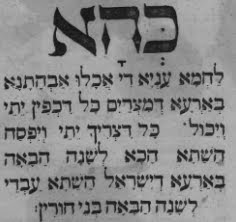Some variant texts begin with ke-Ha Lachma Anya instead:
What is the difference between them? Perhaps nothing, and we should not make any big deal about it. It is either This is the bread of affliction, or like this was the bread of affliction. Either way, the idea is that this is matza; it is the bread of affliction; it is what our ancestors ate in Egypt.
But perhaps we should make a big deal of it. The Mishna in Pesachim reads:
י,ה רבן גמליאל אומר, כל שלא אמר שלושה דברים אלו בפסח, לא יצא ידי חובתו; ואלו הן--פסח, מצה, ומרורים. פסח, על שם שפסח המקום על בתי אבותינו במצריים; מרורים, על שם שמיררו המצריים את חיי אבותינו במצריים; מצה, על שם שנגאלו. בכל דור ודור, חייב אדם לראות את עצמו כאילו הוא יצא ממצריים; לפיכך אנחנו חייבין להודות להלל לשבח לפאר להדר לרומם לגדל לנצח למי שעשה לנו את כל הניסים האלו, והוציאנו מעבדות לחירות. ונאמר לפניו, הללו יה.
But Rambam writes this as leharot et atzmo:
ח [ו] בכל דור ודור, חייב אדם להראות את עצמו כאילו הוא בעצמו יצא עתה משיעבוד מצריים,
And so, apparently in all Kitvei Yad of Rambam on the seder ha-hahagadah. But, we see in perush haMishnayot that it just לראות (credit to Rav Kapach). See e.g. this perush ha-Mishnayot:The answer, says R' Kapach, is that the vocalization is to be larot, with a patach under the lamed rather than a heh. Which then means le-harot.
The difference is: lir`ot is that he should internalize the lesson, and see himself as if he left Egypt. Lar`ot is that he should externalize the lesson, and reenact it overtly for others as though he himself left Egypt. The pasuk cited it asah Hashem li betzeiti Mimitzrayim. This might be self-perception. But the pasuk does begin vehigadta levincha bayom hahu, such that this is a response for others.
Either way, this might entail referring to oneself as a Red-Sea pedestrian.
Back to the topic of the variant texts of ha vs. ke-ha -- Without the kaf, we are saying that this itself is the bread of affliction our forefathers ate. With the kaf, we are simply saying that it is like it, but that it is not precisely it. The former is a stronger reenactment. The latter seems more like a zecher. We might then draw a connection here. If the purpose is lar'ot, then ha is more appropriate than ke-ha.
 What about the rest of it? We could cast it as (at least) one of three things:
What about the rest of it? We could cast it as (at least) one of three things: (1) A quote of what our ancestors said back in Egypt.
(2) A quote of what our ancestors said during the days of the Mikdash.
(3) Something we are saying today.
If (1), then our saying it might well be part of the reenactment. We say that now we are here in Egypt, but next year we will be in Israel. (If not from problems in the midbar, they would be back in the land of Canaan.) And that now in Egypt we are slaves, but next year we will be free men.
If (3), then this could be application of the lesson of Pesach to our own lives. You think that our ancestors were the only ones in need of redemption? Just like them, we are in Exile. And we are (or were) under oppression in various countries, such that we are not free.
Or it could be a combination of the above, with different sentences referring to different people or stages.




6 comments:
Yuck, your new site design scrolls VERY jerky (jerkily?).
thanks; i will try to fix it.
kol tuv,
josh
thanks; i will try to fix it.
kt,
josh
i'm struggling with it.
i think blogger in general might be unresponsive today.
I think the background image had something to do with it. It's loading better now. Anyway, chag kosher v'sameach!
i would guess so. i think it was actually all the images on the page coming from blogger, since many other images failed to load. and because i found this note at status.blogger.com, which it the place to check when blogger in general is having problems, and they note:
"Our image backend is experiencing problems which may affect the display and/or uploading of photos. We are working to resolve this and will update this post when we have more information."
i'm going to try restoring the background image some other day, to see how it impacts performance.
chag kasher vesameach,
josh
Post a Comment